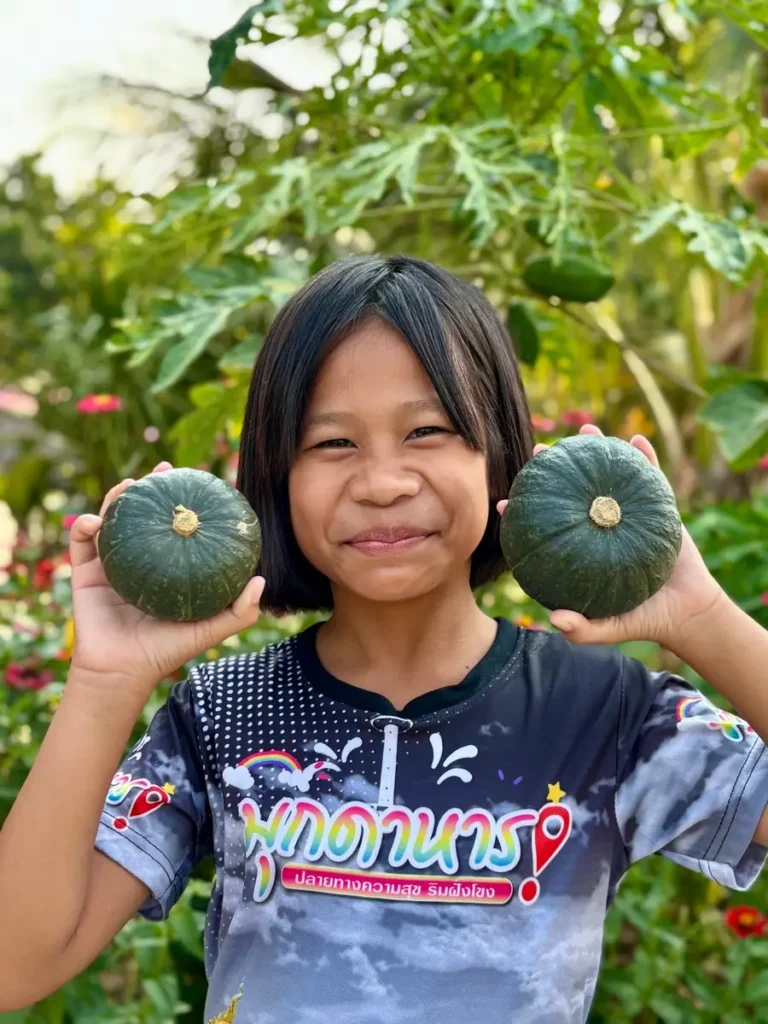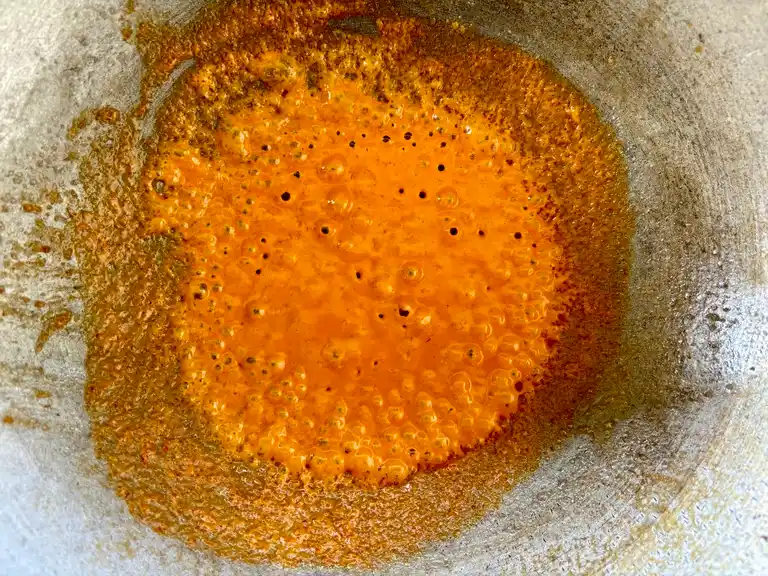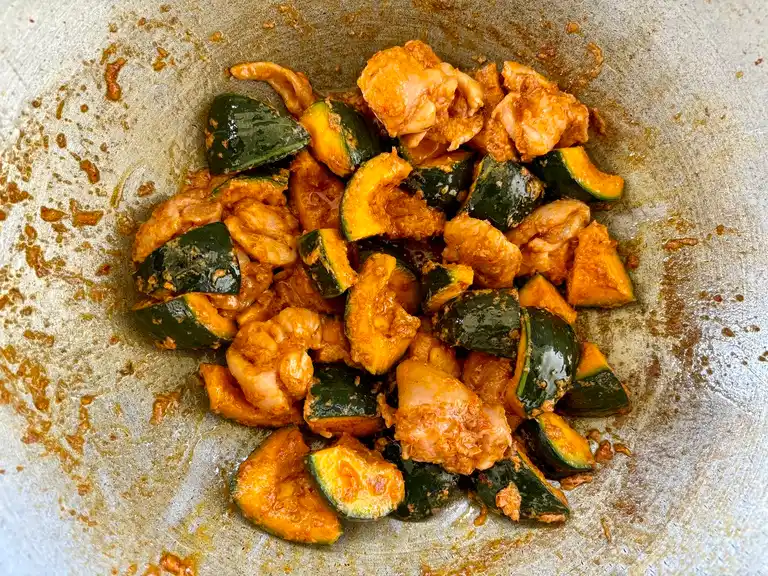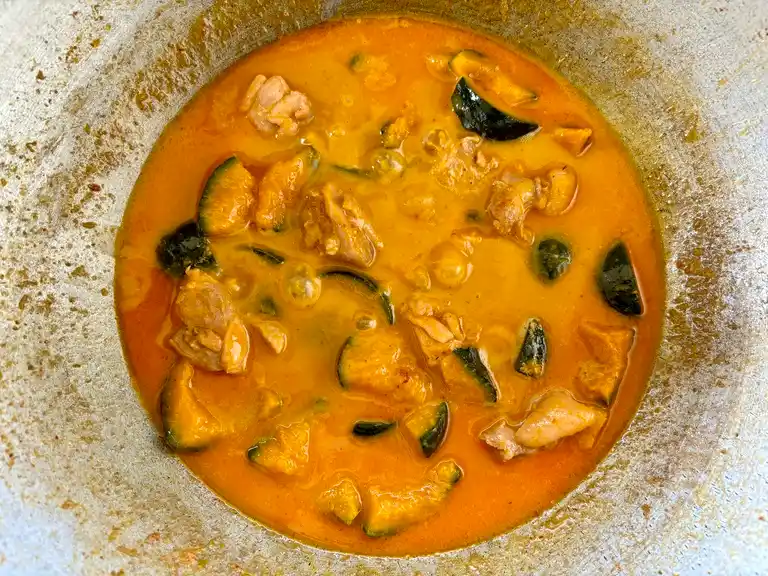Thai Kabocha Squash Curry Recipe
As an Amazon Associate, I earn from qualifying purchases. Read the full disclosure here .
This Thai kabocha squash curry recipe is a creamy dish that’s perfect for every home cook. It’s a perfect mix of sweet and spicy thanks to coconut milk and homemade red curry paste. Serve it with jasmine rice to soak up all that yummy sauce.

My niece is the biggest pumpkin lover EVER. She can’t get enough of steamed pumpkin with a sprinkle of sugar to make it sweet.
I wanted to surprise her with something new and ordered kabocha squash. It’s not exactly a pumpkin, but it’s naturally sweet and looks similar. Upon arrival, they turned out to be the most adorable ones I had ever seen.

In Thailand, eating spicy food starts young. My niece finished a big bowl of this spicy kabocha squash curry without shedding a single tear.
Some of her favorite Thai curries are winter melon and pumpkin curry!
What is kabocha squash curry
Kabocha squash curry is a Thai dish with a base of coconut milk infused with red curry paste. It balances sweet, savory, and spicy flavors and is typically served with jasmine rice.
What is kabocha
Kabocha, also referred to as Japanese pumpkin, is a type of winter squash with a sweet and nutty flavor and a smooth, creamy texture. Kabocha squash is typically used in Japanese cuisine for making soups, stew, and even desserts.
Just like pumpkin, kabocha squash is great for making Thai curry as it’s naturally sweet and a bit nutty. Simmered in the red coconut curry sauce, it becomes deliciously tender and creamy as it soaks up the flavors of the spicy curry sauce.
Thai chicken kabocha curry
Before you start making your Thai kabocha curry, let’s look at a few key steps to make sure it turns out great. Later, I’ll guide you through each step, making sure it’s easy to follow with clear, step-by-step images.
We start this Thai curry by letting some of the coconut milk simmer down a bit. This brings out the coconut oil, adding fragrance and enhancing the overall flavors.
Then, we fry the curry paste with fish sauce and chicken. This technique is another special touch. Instead of just adding fish sauce to the curry, frying it first makes the curry exceptionally fragrant.

The real secret to a great kabocha curry is slow-cooking, just like you’d make Thai massaman chicken curry. Kabocha squash needs time to get soft and release its natural sweetness. As it cooks, it’ll sweeten up the sauce over time.
It’s also crucial to wait on adding sugar until after the kabocha is thoroughly cooked. Then, you can simply taste and see how much sugar you really need so you don’t end up with an overly sweet coconut curry sauce.
My last tip to your make your curry stand out is choosing chicken thighs. They’re ideal for slow cooking because they stay moist, unlike chicken breast. While chicken breast works well for fast-cooking dishes like gaeng daeng, it’s not the best for slow-cooked recipes like this one.
Ingredient notes
Look for all these ingredients at your local Asian market or grocery store. For exact measurements, refer to the recipe card at the end of this post.

- Kabocha squash – Sweetens the curry naturally as it cooks slowly, there’s no need to peel it.
- Red curry paste – My homemade Thai red curry paste is a mix of lemongrass, shrimp paste, and turmeric. Good store-bought alternatives are Mae Ploy and Maesri. You can also use this curry paste in my authentic Thai red curry and Thai mushroom curry.
- Chicken thighs – Since this is a slow-cook curry, it’s important to use chicken thighs.
- Palm sugar – Palm sugar is a common sweetener in Thai cuisine, with a caramel-like sweetness that’s distinct from white and brown sugar.
- Fish sauce – Fish sauce adds a salty, umami depth to the curry that you can’t get from salt alone.
- Kaffir lime leaves – Kaffir lime leaves add an irreplaceable citrusy fragrance and freshness.
- Sweet basil – Brings a refreshing note that perfectly complements the kaffir lime leaves flavor.
- Chilies – Prik chi fa chilies not only add a mild heat but also lots of chili flavor.
- Coconut milk – Full-fat coconut milk makes the curry sauce rich in flavor.
- Water – Water ensures the curry doesn’t become too thick while the squash cooks, as the squash will thicken the curry sauce while it’s cooking.
How to make kabocha squash Thai curry

Step 1: Heat 3/4 cup (200ml) of the coconut milk in a wok or pot over medium heat until the coconut oil begins to separate.

Step 2: Stir in the red curry paste and mix it well with the coconut milk.

Step 3: Add the chicken and fish sauce, making sure the chicken is well coated with the paste.

Step 4: Put the kabocha squash in the wok and cook for 5 minutes.

Step 5: Pour in the rest of the coconut milk and add water.

Step 6: Cover and simmer on low heat for 15–20 minutes, depending on the size of your kabocha pieces.

Step 7: Add chilies, kaffir lime leaves, and palm sugar to taste. Simmer for one more minute.

Step 8: Turn off the heat, stir in the sweet basil, and serve with rice. Enjoy!
Kitchenware
- Mortar and pestle or food processor for making homemade curry paste
- Cutting board and sharp knife
- Ladle for serving and stirring
- Measuring spoons and cups
- Large pot or Dutch oven
Kabocha chicken curry recipe tips
- Simmer slowly: Simmered kabocha makes the curry richer and the squash perfectly soft.
- Squash options: Butternut squash or any winter squash works great too.
- Plant-based: Easily make this curry vegan by skipping the chicken and adding more of your favorite veggies. Swap the fish sauce for a vegan-friendly alternative like salt.
- Vegetables: Feel free to toss in red bell peppers, bamboo shoots, and Thai eggplants.
- Proteins: Avoid using lean meat for this slow-cook curry. You can use fatty pork or a cut of beef that’s suited for slow-cooking.
Red kabocha curry serving suggestions
Thai curries are typically served with a side of jasmine rice or rice vermicelli. In Southern Thai cuisine, a common side for curries is Thai roti. You can choose to serve your curry in a separate bowl or atop the rice in the same dish.
Kabocha pumpkin curry storage
- Storing: Let your leftovers cool to room temperature and transfer it into airtight containers. It can be refrigerated for up to 3 days, so it’s great for meal prep and busy days.
- Freezing: You can freeze your leftovers for up to 2 months. Place the cooler curry in freezer-safe containers or bags. Thaw overnight in the refrigerator before reheating
- Reheating: Reheat on the stove top over medium heat until warm.
How to store kabocha squash
Keep whole Kabocha squash in a cool, dark place like a pantry. It lasts 1 to 3 months this way. If cut, wrap it up or put in a container, and keep in the fridge. Use the cut squash within a week to enjoy its best taste.
Frequently asked questions
Where to buy kabocha squash?
Kabocha squash can usually be found at your local grocery store, farmers’ markets, or Asian supermarkets in the produce section.
Can I make this with an instant pot?
Yes, Thai curries adapt well to an instant pot. Just make sure to adjust the cooking time accordingly.
Is this recipe gluten-free?
Yes, this recipe can be gluten-free, as long as you ensure your red curry paste and fish sauce are gluten-free brands.
Authentic Thai curry recipes
- Gaeng phed ped yang (roasted duck)
- Vegetarian Thai green curry
- Thai beef panang curry
- Gaeng panang gai
- Gang garee curry
- Chicken khao soi
Love this Thai kabocha squash curry recipe? Make my day by dropping a star rating and leaving a comment below! Follow me on social media: Facebook, Instagram, and Pinterest.
Thai Kabocha Squash Curry Recipe

Ingredients
- 300 ml coconut milk, divide into ¾ cup (200 ml) and the remaining amount
- 1 tbsp or 15 g red curry paste
- 200 g chicken thighs, cut into bite-sized pieces
- 1 tbsp or 15 ml fish sauce
- 400 g kabocha squash, cut into bite-sized pieces
- 200 ml water
- 1 prik chi fa chili, sliced, add to taste, see notes
- 0.5 tbsp or 7 g palm sugar, see notes
- 3 kaffir lime leaves, cut into thin strips
- 5 g sweet basil
Instructions
- Heat 3/4 cup (200ml) of the coconut milk in a wok or pot over medium heat until the coconut oil begins to separate.
- Stir in the red curry paste and mix it well with the coconut milk.
- Add the chicken and fish sauce, making sure the chicken is well coated with the paste.
- Put the kabocha squash in the wok and cook for 5 minutes.
- Pour in the rest of the coconut milk and add water.
- Cover and simmer on low heat for 15–20 minutes, depending on the size of your kabocha pieces.
- Add chilies, kaffir lime leaves, and palm sugar to taste. Simmer for one more minute.
- Turn off the heat, stir in the sweet basil, and serve with rice. Enjoy!
Notes
- For the exact measurements, please scroll down to the recipe card at the end of this post.
- Prik chi fa chili - A large, medium spicy Thai pepper. If not available, you can use a different type of pepper.
- Palm sugar -Because kabocha squash is naturally sweet, it's important to wait to add sugar to your curry until the kabocha is cooked. Then, you can taste and see how much sugar you need so you don't end up with an overly sweet curry sauce.
- Red curry paste - Use my homemade Thai red curry paste or good store-bought alternatives like Mae Ploy and Maesri.






